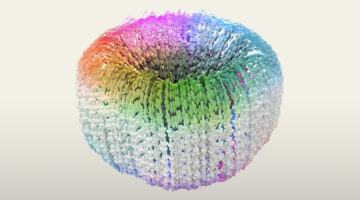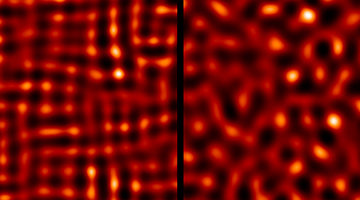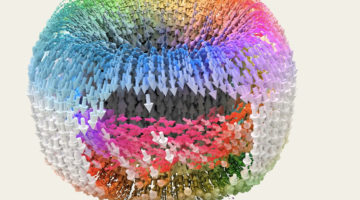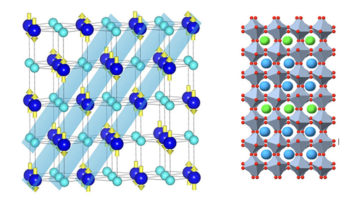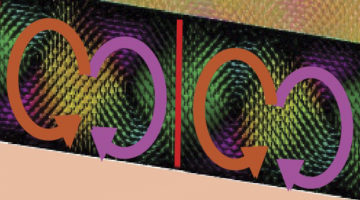Congratulations to Padraic Shafer, this year’s recipient of the Shirley Award for Outstanding Scientific Achievement! Shafer, ALS staff scientist and leader of the ALS’s dichroism program, is being recognized “for unveiling the nature of chiral quantum materials through the innovative use of x-ray scattering at the Advanced Light Source.” Read more »
ALS Work Using RSXD
Resonant soft x-ray diffraction (RSXD) probes the periodic order of electronic and magnetic states in a material by diffracting x-rays (wavelength ~ 1–3 nm) into patterns that are characteristic of the electronic order. The diffraction patterns depend on the x-ray wavelength and polarization to reveal (1) which elements, valence states, electronic orbitals, or magnetic states are ordered; (2) how they are arranged (direction, periodicity, dimensionality); and (3) their symmetry (e.g., chiral arrangements).
Electric Dipoles Form Chiral Skyrmions
Researchers demonstrated that polar skyrmions—cousins of magnetic skyrmions but comprising swirls of electric dipoles instead of spins—exhibit chirality in a material with electrically switchable properties. Control of such phenomena could one day lead to low-power, nonvolatile data storage as well as to high-performance computers. Read more »![]()
![]()
Superconductor Exhibits “Glassy” Electronic Phase
Researchers discovered that electrons in a high-temperature superconductor can exhibit a new type of collective behavior that is more “glassy” (disordered) than expected. The study provides valuable insight into the nature of collective electron behaviors and how they relate to high-temperature superconductivity. Read more »![]()
![]()
Electric Skyrmions Charge Ahead for Next-Generation Data Storage
Researchers have observed chirality for the first time in polar skyrmions in a material with reversible electrical properties. The combination of polar skyrmions and these electrical properties could one day lead to applications such as more powerful data storage devices that hold information even after a device has been powered off. Read more »
A Designed Material Untangles Long-Standing Puzzle
The origin of the metal-to-insulator transition in a key material system was revealed by nanostructures designed to decouple simultaneous phase transitions. This approach could lead to new materials with emergent physics and unique electronic properties, supporting broader research efforts to revolutionize modern electronics. Read more »![]()
![]()
X-Ray Handedness Reveals Handedness of Electronic Vortices
Electronic vortex structures have been found to emerge from engineered samples of alternating complex-oxide layers. Resonant soft x-ray diffraction (RSXD) studies using circularly polarized x-rays revealed the vortices’ left- and right-handedness. The intriguing results open the door to electrically controllable chiral devices. Read more »
X-Rays Reveal ‘Handedness’ in Swirling Electric Vortices
Scientists used spiraling x-rays at the ALS to observe, for the first time, a property that gives handedness to swirling electric patterns—dubbed polar vortices—in a synthetically layered material. Read more »
3D Charge Order Found in Superconductor
Resonant soft x-ray diffraction studies of a cuprate high-temperature superconductor revealed a 3D, long-range charge order—the first of its kind ever reported in a cuprate—that competes with superconductivity. A better understanding of such phenomena could help in the design of more robust superconductors with higher transition temperatures. Read more »![]()
![]()

